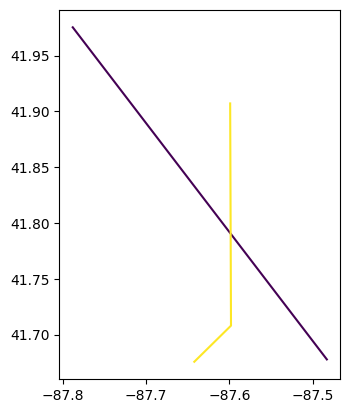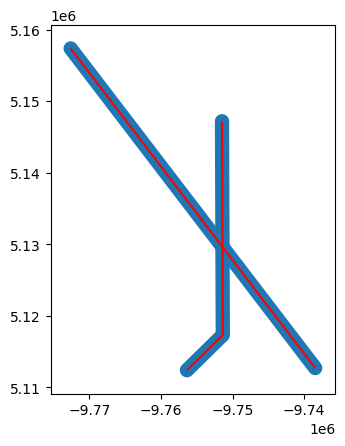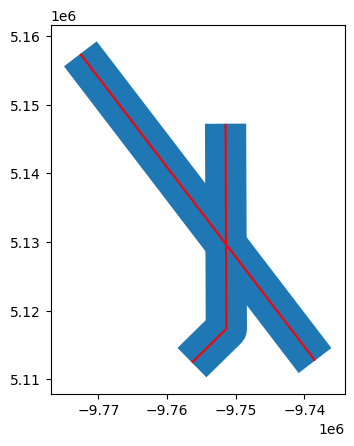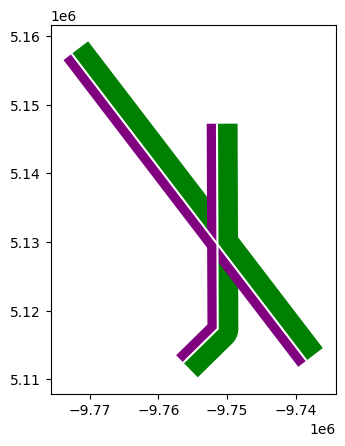邻域分析 —— 缓冲区,最近邻#
深入研究一些最常见的空间运算。在这部分之后,你将能够回答一些简单的问题,比如“最近的温蒂汉堡在哪里?”、“在距离高速公路 50 码范围内是否有住宅?”。
缓冲区分析#
首先,将导入必要的模块。
# Import modules
import pandas as pd
import geopandas as gpd
from shapely.geometry import Point, LineString, Polygon
from io import StringIO
data = """
ID,X,Y
1, -87.789, 41.976
1, -87.482, 41.677
2, -87.599, 41.908
2, -87.598, 41.708
2, -87.643, 41.675
"""
# use StringIO to read in text chunk
df = pd.read_table(StringIO(data), sep=',')
#zip the coordinates into a point object and convert to a GeoData Frame
points = [Point(xy) for xy in zip(df.X, df.Y)]
points = gpd.GeoDataFrame(df, geometry=points, crs = 'EPSG:4326')
# create line for each ID
lines = points.groupby(['ID'])['geometry'].apply(lambda x: LineString(x.tolist()))
lines = gpd.GeoDataFrame(lines, geometry='geometry', crs="EPSG:4326")
lines.reset_index(inplace=True)
看看数据:
# plot county outline and add wells to axis (ax)
lines.plot(column='ID');

重要
永远不要用未被投影的数据(例如 lat lon)进行距离分析。距离最好不要用度数来衡量!而是,使用 .to_crs() 将其转换为投影的坐标系统,以英尺或米等为线性单位。
虽然没有明确说明,但距离参数是用投影的线性单位度量的。因此,在开始之前,需要确保使用 to_crs() 将其转换为投影坐标系。
# plot county outline and add wells to axis (ax)
lines = lines.to_crs(3857)
# check the linear unit name in `unit_name`.
print(lines.crs.axis_info)
[Axis(name=Easting, abbrev=X, direction=east, unit_auth_code=EPSG, unit_code=9001, unit_name=metre), Axis(name=Northing, abbrev=Y, direction=north, unit_auth_code=EPSG, unit_code=9001, unit_name=metre)]
可以开始处理缓冲区函数。你可以阅读文档的缓冲功能,不幸的是被分成两个文档geopandas和shashaely。
buf = lines.buffer(distance = 1000)
bp = buf.plot()
lines.plot(ax=bp, color='red')
print(buf)
0 POLYGON ((-9737657.488 5113325.388, -9737601.7...
1 POLYGON ((-9750364.761 5117342.850, -9750369.3...
dtype: geometry

注意,现在必须使用 polygon GEOMETRIES。它不再具有与之关联的线属性。如果想要添加回属性数据,需要用新的缓冲区几何值替换原来的几何列。
line_buffer = lines.copy()
line_buffer['geometry'] = buf
print(line_buffer)
ID geometry
0 1 POLYGON ((-9737657.488 5113325.388, -9737601.7...
1 2 POLYGON ((-9750364.761 5117342.850, -9750369.3...
还有许多其他参数可以使用,即 cap_style 和 single_sided。
buf = lines.buffer(distance = 3000, cap_style = 2)
bp = buf.plot()
lines.plot(ax=bp, color='red');

属性 |
值 |
|---|---|
round |
1 |
flat |
2 |
square |
3 |
还可以创建左侧或右侧缓冲区。左边使用负距离,右边使用正距离。
buf_right = lines.buffer(distance = 3000, single_sided = True)
bp = buf_right.plot(color='green')
buf_left = lines.buffer(distance = -1500, single_sided = True)
buf_left.plot(ax=bp, color='purple')
lines.plot(ax=bp, color='white');

最近邻分析#
常用的 GIS 任务是能够找到最近的邻居。例如,您可能用 Point 对象表示您的家位置,然后用另一组位置表示公共交通站点。然后,比较典型的问题是“哪一站离我家最近?”这是典型的最近邻分析,其目标是找到与另一个几何最接近的几何。
在 Python 中,这种分析可以通过名为 nearest_points() 的形状良好的函数来完成,该函数返回输入几何图形中最近点的元组。
Shapely 最近的点#
从测试如何使用 Shapely 的 nearest_points() 函数找到最近的点开始。
创建原点(origin Point)和几个目的地点,并找出最近的目的地。
from shapely.geometry import Point, MultiPoint
from shapely.ops import nearest_points
orig = Point(1, 1.67)
dest1, dest2, dest3 = Point(0, 1.45), Point(2, 2), Point(0, 2.5)
为了能够从原点找到最近的目标点,需要从目标点创建 MultiPoint 对象。
destinations = MultiPoint([dest1, dest2, dest3])
print(destinations)
MULTIPOINT (0 1.45, 2 2, 0 2.5)
好了,现在可以看到所有的目标点都表示为单一的多点对象。可以通过使用 nearest_points() 函数找到最近的目标点。
nearest_geoms = nearest_points(orig, destinations)
original_point, nearest_destination = nearest_geoms
print(nearest_geoms)
print('Coordinates of original point:',original_point)
print('Coordinates of closest destination point:',nearest_destination)
(<POINT (1 1.67)>, <POINT (0 1.45)>)
Coordinates of original point: POINT (1 1.67)
Coordinates of closest destination point: POINT (0 1.45)
如您所见,nearest_points 函数返回几何图形元组,其中第一项是原点的几何图形,第二项(在索引 1 处)是距离目标点最近的实际几何图形。因此,最近的目的地点似乎位于坐标 \((0,1.45)\)。
这就是从一组点中找到最近点的基本逻辑。
geopanda 最近的点#
当然,前面的例子还没有真正有用。因此,接下来将展示如何使用 GeoDataFrames 从一组原点到一组目的地点中找到最近的点。在本例中,将重新创建前面的示例,但使用 geopanda,但该数据可以来自任何 shapefile。
首先,需要创建函数,该函数利用前面的函数,但被定制为可以使用两个
GeoDataFrames。
from shapely.ops import nearest_points
def _nearest(row, df1, df2, geom1='geometry', geom2='geometry', df2_column=None):
"""Find the nearest point and return the corresponding value from specified column."""
# create object usable by Shapely
geom_union = df2.unary_union
# Find the geometry that is closest
nearest = df2[geom2] == nearest_points(row[geom1], geom_union)[1]
# Get the corresponding value from df2 (matching is based on the geometry)
if df2_column is None:
value = df2[nearest].index[0]
else:
value = df2[nearest][df2_column].values[0]
return value
def nearest(df1, df2, geom1_col='geometry', geom2_col='geometry', df2_column=None):
"""Find the nearest point and return the corresponding value from specified column.
:param df1: Origin points
:type df1: geopandas.GeoDataFrame
:param df2: Destination points
:type df2: geopandas.GeoDataFrame
:param geom1_col: name of column holding coordinate geometry, defaults to 'geometry'
:type geom1_col: str, optional
:param geom2_col: name of column holding coordinate geometry, defaults to 'geometry'
:type geom2_col: str, optional
:param df2_column: column name to return from df2, defaults to None
:type df2_column: str, optional
:return: df1 with nearest neighbor index or df2_column appended
:rtype: geopandas.GeoDataFrame
"""
df1['nearest_id'] = df1.apply(_nearest, df1=df1, df2=df2,
geom1=geom1_col, geom2=geom2_col,
df2_column=df2_column, axis=1)
return df1
# generate origin and destination points as geodataframe
orig = {'name': ['Origin_1','Origin_2'],
'geometry': [Point(-77.3,38.94),Point(-77.41,39.93)]}
orig = gpd.GeoDataFrame(orig, crs="EPSG:4326")
print(orig)
dest = {'name': ['Baltimore','Washington', 'Fredrick'],
'geometry': [ Point(-76.61,39.29,), Point(-77.04,38.91), Point(-77.40,39.41)]}
dest = gpd.GeoDataFrame(dest, crs="EPSG:4326")
print(dest)
name geometry
0 Origin_1 POINT (-77.30000 38.94000)
1 Origin_2 POINT (-77.41000 39.93000)
name geometry
0 Baltimore POINT (-76.61000 39.29000)
1 Washington POINT (-77.04000 38.91000)
2 Fredrick POINT (-77.40000 39.41000)
找到 df2 到 df1 质心的最近点(从 id 列取值)
nearest = nearest(df1=orig, df2=dest, df2_column='name')
nearest.head()
| name | geometry | nearest_id | |
|---|---|---|---|
| 0 | Origin_1 | POINT (-77.30000 38.94000) | Washington |
| 1 | Origin_2 | POINT (-77.41000 39.93000) | Fredrick |
备注
如果想用多边形做最近邻分析,可以简单地使用质心(centroid)。如果有一个叫 poly 的 geopandas 多边形,运行 poly[‘centroid’] = poly.centroid 以在属性表中存储质心值。
